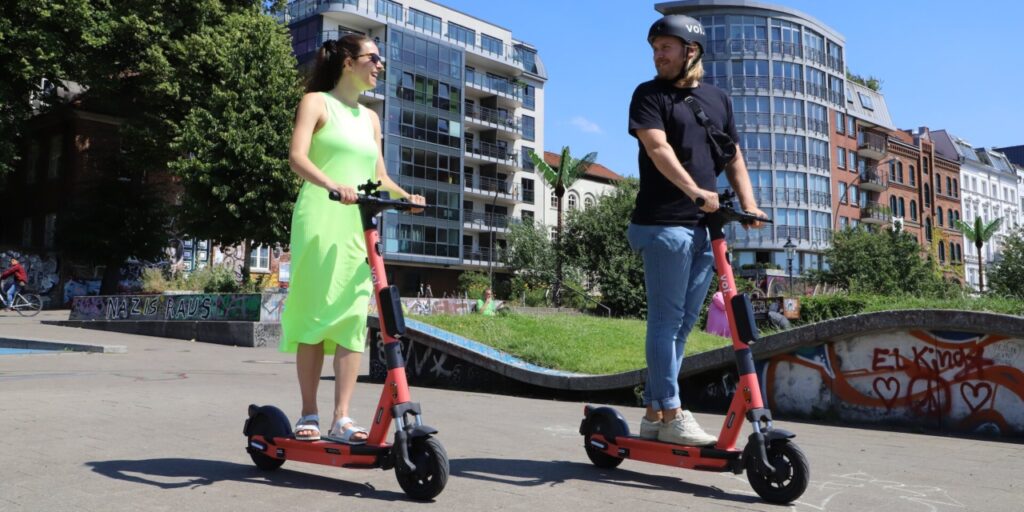- Poorly shovelled sidewalks will lead to slip and falls this winter - December 11, 2024
- Brain injuries are costly on an emotional and physical level - November 22, 2024
- Long-term disability payments could come with a tax liability - October 23, 2024
By Paul Russell, LegalMatters Staff • Getting around urban centres in Ontario can be a hassle. And expensive, when you factor in gas, vehicle costs and parking fees. So it is not surprising that some people are embracing e-scooters as a mode of transportation, which promise quick and easy commutes across the city.
But users have to be aware of the danger of accidents when riding these lightweight vehicles, says Ontario personal injury lawyer Joshua Goldberg.
“The idea of ‘scooting’ around traffic jams and manoeuvring your way through city streets is appealing, but it comes with certain risks,” says Goldberg, principal of Joshua Goldberg Law.
“E-scooters have their place, but also their limitations. Riders have to respect that,” he tells LegalMattersCanada.ca.
Definition of an e-scooter
According to the Ontario government an electric kick-scooter (e-scooter) is a vehicle that has:
- two wheels (one at the front and one at the back);
- a platform to stand on;
- a handlebar for steering;
- an electric motor that does not exceed 500 watts; and
- a maximum speed of 24 km/hr on a level surface.
The Ontario government is running a five-year pilot project for e-scooters that ends on Jan 1, 2025. It allows municipalities to decide where these vehicles may be operated, such as roads, bike paths, parks or on trails.
Riders must be at least 16 years old and must wear a bicycle helmet if they are under 18 years old, with municipalities given the option of requiring insurance,
“Cities and towns that want to allow e-scooters to operate on their roads must pass bylaws to permit their use and set out specific requirements about their operation,” says Goldberg.
In all cases, e-scooter drivers are not allowed to carry passengers or cargo or ride on controlled-access highways such as the 400-series highways. Anyone violating these rules faces penalties ranging from $250 to $2,500.
Not embraced by all municipalities
When the provincial government announced the five-year e-scooter pilot project in 2019, it stated that these vehicles have the “potential to help hundreds of thousands of commuters get to transit connections, reduce congestion, and open the Ontario market to a new and growing sector.”
Some municipalities have E-scooter rideshare programs that allow subscribers to rent an e-scooter for a short period, then leave the e-scooter for its next rider to collect, similar to bike-sharing programs.
In Brampton, 750 e-scooters are available to the public. According to city regulations, they can be used on roads with a speed limit of 50 km/h or less, bicycle lanes, and multi-use paths, but not sidewalks. If an E-scooter is taken into a designated no-riding zone, the vehicle shuts off smoothly and the user receives a notification that they should proceed to a permitted area.
- Every successful personal injury case has one key element
- Know the deadlines when pursuing a personal injury case
- Cycling has many benefits but it also comes with risk
“The Brampton model sounds promising, but other major municipalities have not signed on,” says Goldberg. “Such as Toronto, which in 2021 decided that e-scooters are “not allowed to be operated, left, stored or parked on any public street in Toronto including bicycle lanes, cycle tracks, trails, paths, sidewalks or parks … over safety and accessibility concerns.’”
Despite that decision, he notes that the number of e-scooters on Toronto streets is steadily increasing
A news report states “the city is moving one step closer to reversing that decision.” According to the story, one city councillor states, “The number of scooters that I’m seeing on the street is exploding and we’re not doing anything right now to enforce the [ban].”
Real concerns about safety
“While e-scooters seem like a great mode of transportation, there are safety concerns that have to be addressed,” says Goldberg.
He points to an e-scooter pilot program launched in Calgary. According to a news report, the e-scooter rental program is “very popular, with 540,000 rides being taken by approximately 140,000 users.
“On the downside, close to 500 people had to visit a Calgary emergency room to deal with injuries they suffered on e-scooters,” says Goldberg
South of the border, a February 2019 report from Consumer Reports estimated that there had been 1,500 e-scooter injuries in the United States since late 2017.
“We’ve had multiple concussions, nasal fractures, bilateral forearm fractures, and some people have required surgery,” a U.S. doctor states in the article.
In Canada, a news report titled Just how dangerous are e-scooters? found the injury rate from them is “almost 600 times higher than taking the bus … new data on safety makes it unlikely that many Torontonians will use them as part of their daily commute.”
“Electric scooters may be compact and a cheap way of travelling, but the risk of injury cannot be ignored,” says Goldberg. “If an accident happens due to the actions or negligence of others, you may have the basis for filing a claim for compensation,”
“If you are hurt on an e-scooter, contact a personal injury lawyer,” he adds. “Arrange a free, no-obligation consultation to discuss your legal options.”

